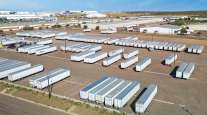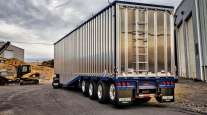Senior Reporter
US Trailer Orders Flat in August; Inventory Rising as GHG 2 Nears

August trailer orders were flat year-over-year at 15,600, but several industry issues are clearly heating up.
From a business standpoint, inventory is elevated — across both new and used trailers. On the government front, industry experts said there is concern with the lack of progress on tax reform and infrastructure bills and also the uncertainty surrounding the fate of the trailer portion of the greenhouse gas Phase 2 rule scheduled to take effect in January.
U.S. trailer orders rose 1% from 15,419 a year earlier, ACT Research Co. reported, citing a preliminary total before trailer makers’ incremental adjustments are available. In August, orders “softened” for dry vans and reefers, compared with recent months, and it was a “weak” month for flatbeds, said Frank Maly, ACT’s director of commercial vehicle transportation analysis and research.
The research company FTR pegged net orders at 14,600.
Build rates remained “sturdy” for van trailers, and the vocational segments held “steady,” while backlogs are lower year-over-year but should start to recover in a couple months, according to FTR.
“Inventory is higher than it was last year in the refrigerated sector and demand seems to be coming down,” said Don Ake, vice president, commercial sector, at FTR. Makers of refrigerated trailers are no longer in a “catch-up “ mode, he added.
The political climate affects our segments greatly. Uncertainty causes our customer base to push out orders.
East Manufacturing President Dave de Poincy
Trailer makers are, however, in a wait-and-see mode as federal regulators take a harder look at GHG 2 rules set to take effect in January.
“We have this 500-pound gorilla in the room, and it is GHG 2,” Maly said. “The Environmental Protection Agency has expressed interest in revisiting the regulations. Well, what does ‘revisiting’ mean? Also the [Truck Trailer Manufacturers Association’s] court case is still in process,” he said Sept. 19.
TTMA challenged EPA’s authority to regulate trailers for the first time ever to help increase fuel efficiency for heavy-duty trucks.
“There is [industry] uncertainty about what exactly will have to be delivered [on trailers] by the end of the year,” Maly added, and that could have a “short-term” impact on production and orders.
Meanwhile, one trailer maker executive is still waiting for Washington to deliver business-friendly policies.
“The political climate affects our segments greatly,” Dave de Poincy, president of East Manufacturing Corp., told Transport Topics. “Uncertainty causes our customer base to push out orders. If a tax bill can get traction it would also drive future orders.”
East Manufacturing builds all-aluminum trailers for the dump, platform and refuse segments. An infrastructure bill would boost orders in the platform and dump segments, he said.
So far, September order volume is average for all segments, he said, and not yet up enough to reach the company’s forecast of a 26% increase year-over-year.
Also, there are high levels of inventory in the system for vans, reefers and platform trailers, de Poincy said.
“Many times when this happens, a downturn in business follows. East does not build much factory stock so we don’t even show up on those charts,” he said. “I can see a scenario that includes 2018 as a down year, especially if nothing gets done in Washington.”
David Giesen, vice president of sales at Stoughton Trailers, awaited final industry data for the month but agreed new trailer inventory is high.
“Depending on what is reported in this [final] number that may be of concern. If backlogs were not so healthy, I would be concerned that this is an indication of industry at over-capacity,” Giesen said.
Stoughton has filled its build slots for the remainder of 2017, he added.
At Hyundai Translead the report from customers was mixed, said Glenn Harney, chief sales officer for Hyundai Translead.
Customers’ outlooks range “from very optimistic to ‘caution for now.’ Carriers are happy that freight is picking up, but rates have been slower to follow,” Harney said.
August orders for dry vans were down “a bit” and “up a little” for reefers, he said.
Its inventory is “pretty low,” Harney said, with “more trailers than usual sold, but not delivered. Peak season will clear most of these out.”
Larry Roland, director of marketing for Utility Trailer Manufacturing Co., said dry van orders were strongest, although all segments improved. The company also sells refrigerated vans and flatbeds.
However, “used-reefer trailer prices are down more than normal due to increased national inventory and lower demand,” Roland said.
At Strick Trailers, production schedules are now set “deep into” the first quarter, said Charles Willmott, chief sales officer at Strick Group.
However, margins are being challenged by material increases and a 10% to 15% increase in overall dry van manufacturing capacity in the last year “to now exceed all previous levels of peak demand,” in his estimation.
Still, inventories for its “most common products” are depleted, he added. “We are confident that 2018 orders will be strong.”





